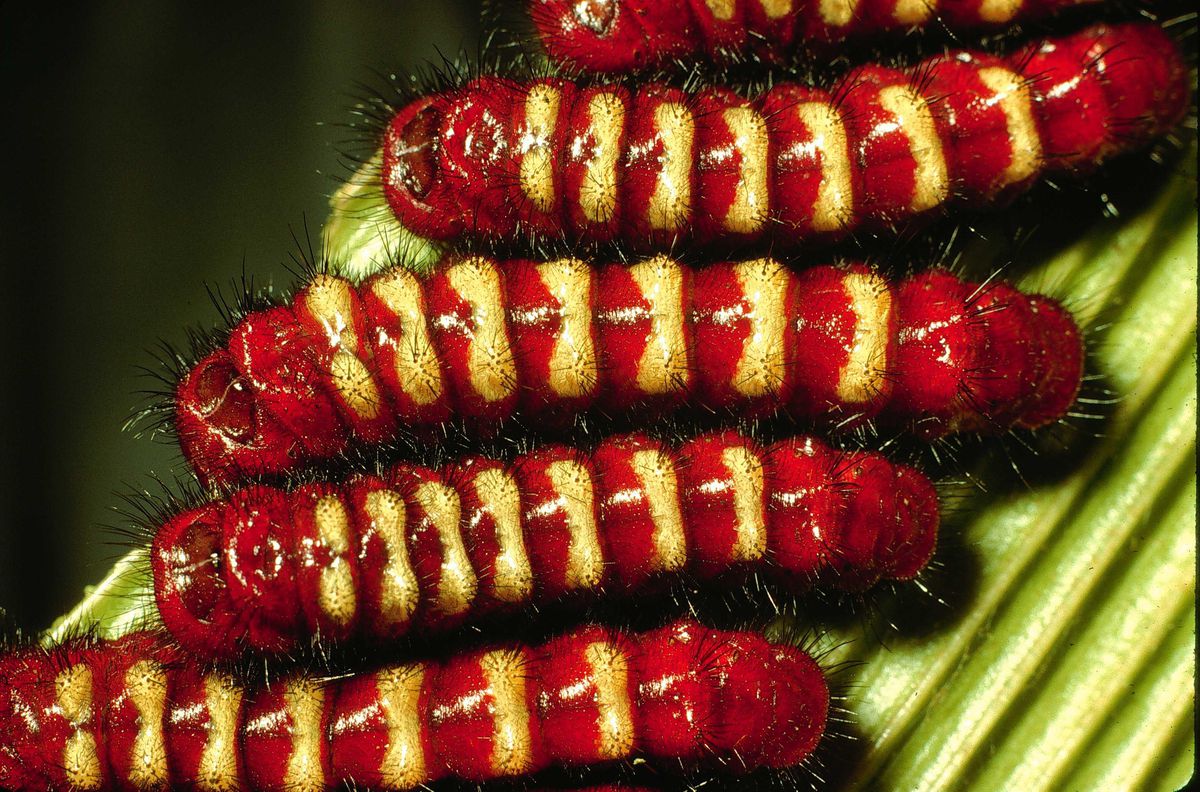
The vivid colors of the Eumaeus butterfly are a sign that they are highly toxic.
Robert Robbins
They may be beautiful, but the gorgeous coloring of the Atala butterfly is a signal to would-be predators that it is highly poisonous. It’s a common strategy in nature: brightly colored species are often toxic to those who eat them.
Most butterflies are not toxic, which has made scientists at the Smithsonian National Museum of Natural History scratch their heads. Why are six butterfly species in the genus Eumaeus (Eumaeus atala and its close relatives) poisonous while so many other butterflies are not?
“Butterflies don’t have teeth or claws to defend themselves,” said the museum’s butterfly curator Bob Robbins. “But they use their wing color and flight behavior as a signal of their unsavory qualities to predators, sometimes deceptively and in others truthfully, as in the case of Eumaeus.”
It starts when they are caterpillars: Eumaeus gorge themselves on plants called cycads. Cycads are as old as the dinosaurs, and are full of a powerful liver toxin called cycasin. And that’s something they show off. Rather than hiding from predators, the bright red and gold caterpillars flaunt themselves in groups on cycad leaves.

Eumaeus godartii caterpillars show off their bright red and gold coloring as they eat toxic cycad … [+]
Janzen Hallwachs
When they emerge from their cocoons, the Eumaeus butterflies emerge as brightly colored adults full of the cycasin toxin. They are also known for their lazy flight pattern, as if they’re not in any hurry. Why should they be? Predators know to leave them alone.
Toxic butterflys and their nontoxic relatives
But the Eumaeus genus is part of the hairstreak group of butterflies, whose appearance and behavior are very different. There are a thousand members of the hairstreak family, commonly found throughout the Americas. Despite how common they are, you’ve probably never heard of them. That’s because hairstreak butterflies are typically small, good at hiding and not much to look at. Which also applies to their caterpillar phase, when they are well-camouflaged and protect themselves from predators by avoiding groups while they feed on a variety of plants.
In fact, the Eumaeus look and behave so differently from the other hairstreaks, that scientists have argued over whether they are actually hairstreaks after all. Researchers also believe that Eumaeus butterflies much have become tolerant to cycasin a very long time ago, since cycad plants are so ancient. In other words, at some point Eumaeus caterpillars started eating cycads and then evolved their bright colors and care-free behavior.
The scientists wanted to learn how Eumaeus and other butterflies were related, and more about their ability to tolerate toxins. They did it by studying the genes of 46 sequenced butterflies, including all six members of Eumaeus and a number of other hairstreaks butterflies. “With the newfound ability to sequence genomes with relative ease, we have the opportunity to look at that in great detail for the first time,” said Robbins.

A male Eumaeus atala butterfly. It’s bright colors indicate how toxic it is to predators.
Robert Robbins
It turned out that Eumaeus are closely related to two typical non-toxic genera within the hairstreaks, the Theorema and Mithras. But the genomes of Eumaeus had a surprising number of differences in genes that built certain proteins. Theorema also had genes involved in coding proteins that the researchers considered ‘fast-evolving.’ The researchers compared the two genomes and focused only on the genetic changes that were unique to each group.
“Sure enough, there was a core group of proteins that had gone through a lot of rapid change in Eumaeus but not in the hairstreaks that don’t eat cycads,” Robbins said. “When we looked at the function of the proteins that changed quickly, it was very strong on the proteins that would destroy cells, proteins that would remove dead cell debris and proteins to create new cells.”
In other words, the Eumaeus caterpillars were not immune to the toxic cycasin they were eating. Instead, they had evolved a process of disposing of damaged cells and growing new ones. “If the cycad toxins were killing cells at high rates, the organism would need to break those cells down, clean them out and then very rapidly make new ones to avoid any ill effects,” he said.
A group of genes evolved together
When Eumaeus gained the ability to tolerate cycad poison as a food source, a burst of rapid evolution gave them traits that were different from other hairstreaks. Bright warning colors and slow lazy flight patterns emerged in the Eumaeus genes at the same time as their change in diet.
The appearance of related traits in tandem to a change in behavior may be the most interesting finding in the study. Stories of how species change due to a key factor in their environment open new possibilities in how we understand inheritance and evolution. We are only scratching the surface.
This article is auto-generated by Algorithm Source: www.forbes.com


